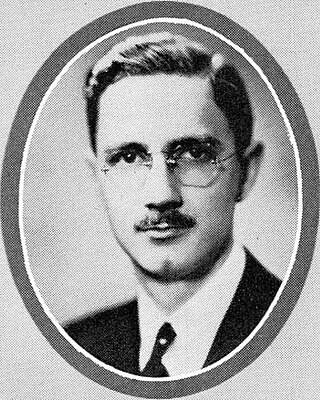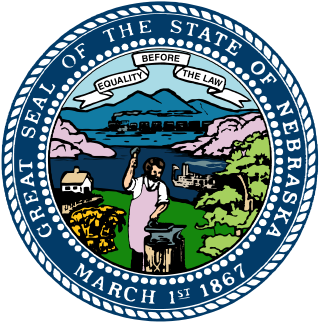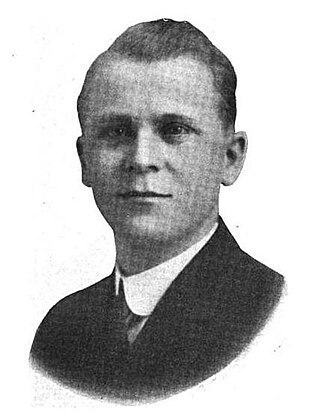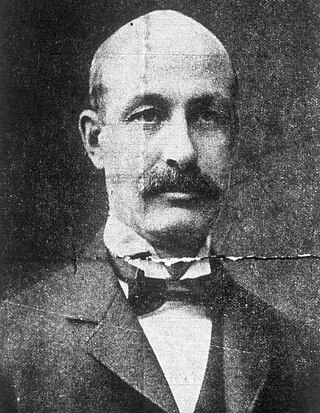
There have been 91 gubernatorial elections in the state of New York since 1777, with the most recent being held on November 8, 2022. The next election is scheduled to be held on November 3, 2026.
The following table indicates the party of elected officials in the U.S. state of Maine:

United States gubernatorial elections were held on November 8, 2022, in 36 states and three territories. As most governors serve four-year terms, the last regular gubernatorial elections for all but two of the seats took place in 2018. The gubernatorial elections took place concurrently with several other federal, state, and local elections, as part of the 2022 midterm elections.

The 1914 Wisconsin gubernatorial election was held on November 3, 1914. Primary elections were held on September 1, 1914.

The 1876 Colorado gubernatorial election took place on October 3, 1876, to elect the 1st Governor of Colorado after the state was admitted to the union on August 1, 1876. Republican John Long Routt, last governor of the Colorado Territory, was elected in a close race against Democratic nominee Bela M. Hughes.

The 1881 Wisconsin gubernatorial election was held on November 8, 1881.

The 1880 Illinois gubernatorial election was held on November 2, 1880.

The 1884 Illinois gubernatorial election was held on November 4, 1884.

The 1882 Nebraska gubernatorial election was held on November 7, 1882. Incumbent Republican governor Albinus Nance did not seek reelection. This election featured James W. Dawes, a Republican, defeating Democratic nominee J. Sterling Morton and Greenback nominee Edward P. Ingersoll.

The 1876 Nebraska gubernatorial election was held on November 7, 1876. It was the first election held under the newly adopted Nebraska Constitution of 1875. The election featured incumbent Governor Silas Garber, a Republican, defeating Democratic nominee Paren England, a lawyer from Lancaster County, Nebraska, and Greenback Party nominee Jonathan F. Gardner, former independent candidate for Governor of Nebraska in 1874.

The 1938 Nebraska lieutenant gubernatorial elections were both held on November 8, 1938. Incumbent Nebraska Lieutenant Governor Walter H. Jurgensen was convicted of a felony in March 1938 and barred from running for a fourth term as lieutenant governor in June, 1938, leaving the 1938 lieutenant gubernatorial race wide open. The vacancy caused by his removal from office brought about two elections for lieutenant governor in 1938: the regular election which always happened biennially and a special election to fill the vacancy.

The 1918 Nebraska lieutenant gubernatorial election was held on November 5, 1918, and featured Republican nominee Pelham A. Barrows defeating Democratic nominee William B. Banning as well as Prohibition Party nominee David B. Gilbert. Incumbent Nebraska Lieutenant Governor Edgar Howard decided not to seek reelection to the office of lieutenant governor in order to run for US Senate, but he was defeated in the Democratic primaries by John H. Morehead.

The 1878 Nebraska lieutenant gubernatorial election was held on November 5, 1878, and featured Republican nominee Edmund C. Carns defeating Greenback and Democratic nominee Theron M. Blakely as well as the original Democratic nominee F. J. Mead who still received some votes. Originally, the Democratic party had nominated F. J. Mead for lieutenant governor. However, in late October 1878, the state central committees of the Democratic and Greenback parties met in Lincoln, Nebraska, and decided to replace F. J. Mead with Greenback candidate Theron M. Blakely on the ticket for lieutenant governor.

The 1880 Nebraska lieutenant gubernatorial election was held on November 2, 1880, and featured incumbent Nebraska Lieutenant Governor Edmund C. Carns, a Republican, defeating Democratic nominee T. J. Hamilton as well as Greenback nominee Peter Lansing and former Democratic nominee Samuel H. Calhoun. Originally, the Democratic party had nominated Calhoun for lieutenant governor. However, on October 11, 1880, Calhoun withdrew his candidacy, and the Democratic state central committee appointed T. J. Hamilton to replace him.

The 1882 Nebraska lieutenant gubernatorial election was held on November 7, 1882, and featured Republican nominee Alfred W. Agee defeating Democratic nominee Jesse F. Warner as well as Greenback nominee D. P. Reynolds.

The 1884 Nebraska lieutenant gubernatorial election was held on November 4, 1884, and featured Republican nominee Hibbard H. Shedd defeating fusion Democratic and Greenback (Anti-Monopoly) nominee Lewis C. Pace. Incumbent Nebraska Lieutenant Governor Alfred W. Agee was renominated at the Nebraska Republican state convention, but he was defeated for the nomination by Shedd by a vote of 292 to 153 of the delegates.

The 1912 Nebraska lieutenant gubernatorial election was held on November 5, 1912, and featured Republican nominee Samuel Roy McKelvie defeating Democratic nominee Herman Diers as well as Socialist Party nominee W. T. Jeffryes and Prohibition Party nominee Theodore J. Shrode.

The 1910 Nebraska lieutenant gubernatorial election was held on November 8, 1910, and featured incumbent Nebraska Lieutenant Governor Melville R. Hopewell, a Republican, defeating Democratic nominee Ralph A. Clark as well as Socialist Party nominee George L. Slutter and Prohibition Party nominee Samuel Lichty.

The 1888 Nebraska lieutenant gubernatorial election was held on November 6, 1888, and featured Republican nominee George de Rue Meiklejohn defeating Democratic nominee Frank Folda as well as Prohibition Party nominee John Dale and Union Labor nominee C. W. Potter.

The 1902 Nebraska lieutenant gubernatorial election was held on November 4, 1902, and featured Republican nominee Edmund G. McGilton defeating Edward A. Gilbert, the Populist and Democratic fusion nominee, as well as Prohibition nominee Isaiah Lightner and Socialist nominee Andrew D. Peugh.


















